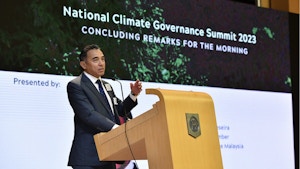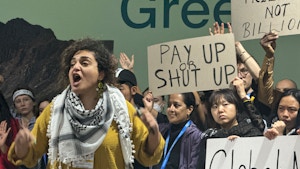Policymakers may have celebrated the creation of a “loss and damage” fund to support climate action in developing countries at last year’s COP climate talks, but securing sufficient finance for the fund remains a point of contention.
To continue reading, subscribe to Eco‑Business.
There's something for everyone. We offer a range of subscription plans.
- Access our stories and receive our Insights Weekly newsletter with the free EB Member plan.
- Unlock unlimited access to our content and archive with EB Circle.
- Publish your content with EB Premium.
This was evident when wealthy countries refused to include loss and damage financing within the scope of a new climate finance goal at the technical expert dialogue held in Baku, Azerbaijan, just two months away from the 29th United Nations climate change conference.
Loss and damage refers to climate impacts that go beyond what communities can adapt to, such as the loss of homes and lives during extreme weather events, such as severe storms.
During the week-long meeting that ended on 12 September, Norway contended that loss and damage should not be part of the new collective quantified goal, known as the NCQG.
NCQG is a new climate finance goal meant to replace a US$100 billion annual funding target that wealthy nations agreed to pay to help climate-vulnerable nations after the COP15 talks in 2009. That funding has proved slow to materialise.

A representative from Norway notes how loss and damage should not be part of the new collective quantified goal (NCQG,) at the 11th Technical Expert Dialogue (TED) and the third meeting under the Ad Hoc Work Programme (AHWP) on NCQG held in Baku, Azerbaijan in 12 to 19 September. Image: UNFCCC
Although the structure of the NCQG will not be determined until COP29 in November, the exclusion of one of the main pillars of climate action in this round of talks may put it in danger of being an “empty shell” of funds, said Tasmeen Essop, executive director of nonprofit Climate Action Network International.
Global climate governance is organised around mitigation and adaptation as well as loss and damage.
“We say that developed countries agreed to establish the loss and damage fund but refuse in the context of the NCQG negotiations to have a dedicated sub-goal for loss and damage, claiming that the goal should only cover mitigation and adaptation,” Essop told Eco-Business.
“This could in practice leave the fund without adequate finance to address loss and damage at the scale of what is needed.”
As of last year’s climate summit in Dubai, wealthy countries most responsible for the climate emergency have pledged a combined total of almost US$800 million to the fund, which has not been added to since then. That financial outlay is the equivalent of less than 0.2 per cent of the irreversible economic and non-economic losses developing countries are facing from global heating every year.
“
This [exclusion of loss and damage from the NCQG] could in practice leave the fund without adequate finance to address loss and damage at the scale of what is needed.
Tasmeen Essop, executive director, Climate Action Network International
Loss and damage funding must be implemented under the NCQG for governments of developed countries to pledge public finance into it, said Mariana Paoli, global advocacy lead of United Kingdom-based nonprofit Christian Aid, who was one of the observers at the technical meeting.
Public finance is the way to provide grants and concessional funding consistent with justice and equity, while private finance is insufficient and limited for mitigation, often neglecting adaptation, and it is “completely inadequate for loss and damage”, Paoli added.
But the exclusion comes as “no surprise” because loss and damage has been sitting in a “precarious position” even before it was operationalised in COP28, said Jefferson Chua, a campaigner for environmental watchdog Greenpeace.
“It has always been a Global South concern, that a lot of developed countries refuse to accept because of historical emissions responsibilities that run through the climate negotiations, not just for loss and damage,” he told Eco-Business.
One of the most heated debates at climate negotiations has been whether rich nations should compensate poorer nations for the damages caused by rising temperatures as they are disproportionately responsible for global warming since the start of the industrial revolution.
Rich countries, including the United States, Canada, Japan and much of western Europe, account for just 12 per cent of the global population today but are responsible for half of all the planet-warming greenhouse gases released from fossil fuels and industry over the past 170 years.
On Saturday, the loss and damage fund board named Amercan Senegalese finance specialist Ibrahima Cheikh Diong as its first executive director, where he will provide strategic leadership and oversight of its secretariat and assist the board in delivering the disbursement.
With the Philippines selected as the host of the fund’s board and Diong’s appointment, the fund can begin turning the pledges from COP28 into the first tranche of financial aid to be disbursed in 2025, Babayev said in a statement. He said he will also call on countries to contribute more money during the November conference.
After the outcomes in Baku, an informal high-level ministerial dialogue will be held in the city on 27 September to further discuss whether loss and damage will be addressed under the NCQG and how it will be reflected in the final decision at COP29.
No agreed amount for new finance goal
Besides loss and damage not being part of the NCQG, the meeting also ended without consensus on the total value of the fund, despite being discussed for the past three years since COP26.
At the dialogue, developing countries called for a US$1 to 2 trillion per year fund, while civil society and trade unions proposed at least US$5 trillion per year.
Data from the Organisation for Economic Cooperation and Development (OECD) showed that climate finance pledged by wealthy nations reached US$80 billion but Oxfam revealed the true value of financing is US$22 billion – only a quarter of what developed countries had reported.
Similar to the pre-COP talks in Bonn in June, the discussion failed to make progress on the new funding target due to divisions over whether wealthier developing nations like China and Saudi Arabia should also pay up on top of developed countries, which have historically contributed the most to global warming.
Canada and Switzerland’s country positions included for the first time detailed criteria for assessing whether a country should be included in the list of contributors to the new goal or not, which was opposed by the like-minded developing countries negotiating bloc, which included China and Saudi Arabia.
Christian Aid’s Paoli said: “It is shameful how developed countries have been undermining these finance negotiations … If we get a weak finance outcome at COP29 it will be their fault and devastating for communities in the global south. It could also threaten negotiations for COP30 as the nationally determined contributions will also depend on available resources to be implemented.”
This article was updated on 21 September to reflect the appointment of Ibrahima Cheikh Diong as executive director of the loss and damage fund in Baku, Azerbaijan.














